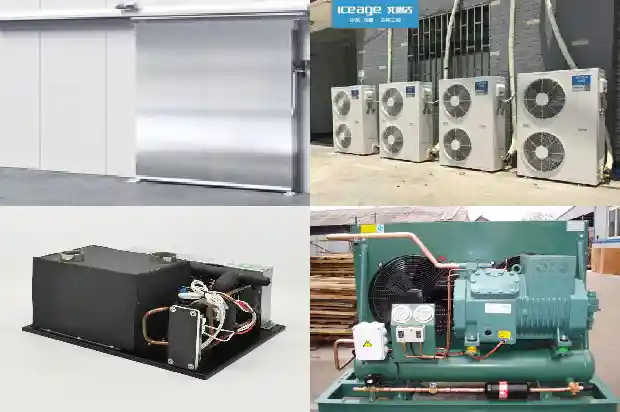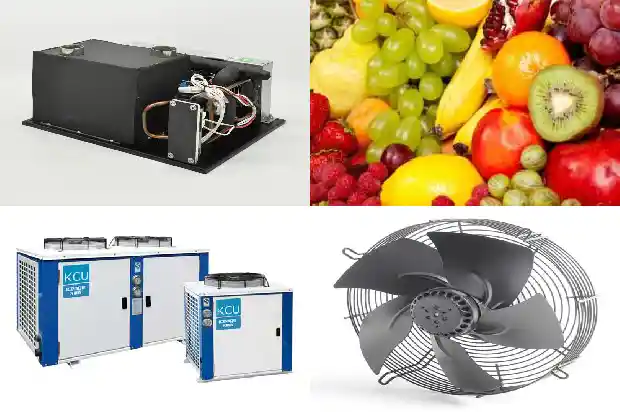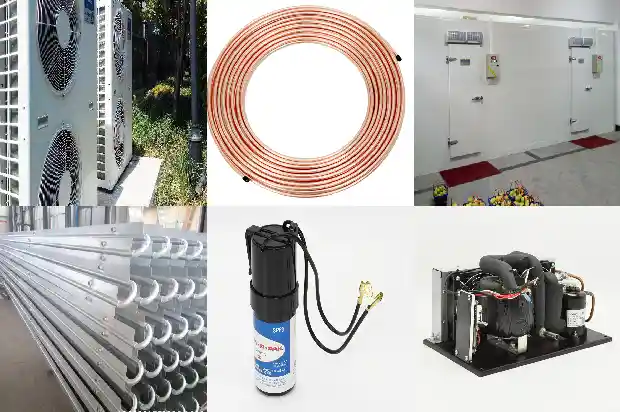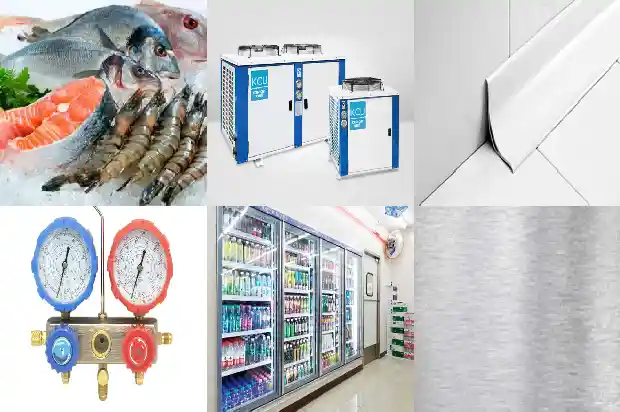Analysis of Installation Requirements and Common Precautions for Cold Storage
2025-04-11
I. Installation Requirements for Prefabricated Cold Storage:
- Collect materials from the parts warehouse according to the construction material list of the project design, and carefully check the types of materials and parts.
- Before installing the cold storage, check the quantity of the cold storage panels according to the delivery note. When loading and unloading the storage panels, handle them gently.
Lay an anti-scratch layer on each layer of the storage panels and the joint of the ground.
- When assembling the cold storage as a whole, there should be a gap between it and the wall and the roof. The ground or the bottom plate must be level, and the construction environment should be clean.
- Before fixing the interior of the storage body with angle aluminum, seal it with glass glue, and then fix it firmly with angle aluminum by riveting. The spacing of the rivets is 300 mm. The spacing on the upper and lower sides of the door is 100 mm.
II. Technical Requirements for the Installation of Air Coolers: - When selecting the position of the hanging point, first consider the position with the best air circulation. Secondly, consider the structural direction of the storage body.
- The gap between the air cooler and the storage panel should be larger than the thickness of the air cooler.
- All the hanging bolts of the air cooler should be tightened. And seal the bolt and hanging bolt perforations with sealant to prevent cold bridges and air leakage.
- When the ceiling fan is too heavy, use No. 4 or No. 5 angle iron as a lintel. The lintel should span to another top plate and wall plate to reduce the load-bearing.
III. Installation Requirements for the Refrigeration Unit: - An oil separator should be installed for both semi-hermetic and fully hermetic compressors, and an appropriate amount of lubricating oil should be added to the oil separator. When the evaporation temperature is lower than -15 degrees, a gas-liquid separator should be installed and an appropriate amount of refrigeration oil should be added.
- A shock-absorbing rubber mount should be installed on the compressor base.
- There should be a maintenance space left for the installation of the unit to facilitate the observation of the adjustment of instruments and valves.
- The high-pressure gauge should be installed at the tee of the liquid receiver valve.
- The overall layout of the unit should be reasonable and the color should be consistent. The installation structure of each model of the unit should be the same.
IV. Installation Requirements for the Refrigeration Pipeline: - The selection of the copper pipe diameter should be strictly in accordance with the interface diameter of the compressor suction and discharge valves. When the distance between the condenser and the compressor exceeds 3 meters, the pipeline diameter should be increased.
- Keep a distance of more than 400 mm between the air suction surface of the condenser and the wall, and keep a distance of more than 3 meters between the air outlet and the obstacle.
- The inlet and outlet pipe diameters of the liquid receiver should be subject to the exhaust and liquid outlet pipe diameters indicated in the unit sample.
- The compressor suction pipeline and the air cooler return pipeline should not be smaller than the size indicated in the sample to reduce the internal resistance of the evaporation pipeline.

- When making the regulating station, each liquid outlet pipe should be sawed into a 45-degree bevel and inserted to the bottom end, and the liquid inlet pipe should be inserted into one-fourth of the diameter of the regulating station.
- The exhaust pipe and the return pipe should have a certain slope. When the condenser is higher than the compressor, the exhaust pipe should slope towards the condenser and a liquid ring should be installed at the compressor exhaust port. Prevent the gas from cooling and liquefying and flowing back to the high-pressure exhaust port after the machine stops, and cause liquid compression when the machine is started again.
- A U-shaped bend should be installed at the outlet of the air cooler return pipeline. The return pipeline should slope towards the compressor direction to ensure smooth oil return.
- The expansion valve should be installed as close as possible to the air cooler. The solenoid valve should be installed horizontally, with the valve body vertical and pay attention to the liquid outlet direction.
- Install a filter on the compressor return pipeline when necessary to prevent dirt in the system from entering the compressor and remove the moisture in the system.
- Before tightening all the nuts and lock nuts in the refrigeration system, apply refrigeration oil for lubrication to enhance the tightness.
Wipe them clean after tightening. Tighten the packing of each stop valve.
- Fasten the thermal bulb of the expansion valve to the outlet of the evaporator at a distance of 100 mm - 200 mm with a metal clip, and wrap it tightly with double-layer thermal insulation.
- After the installation of the refrigeration system is completed, it should be aesthetically pleasing as a whole and the color should be consistent. There should be no phenomena such as pipeline intersection and uneven height.
- When welding the refrigeration pipeline, a sewage discharge port should be left. Use nitrogen to blow the dirt section by section from the high and low pressure. After the section-by-section dirt blowing is completed, blow the dirt of the whole system until no dirt is seen, which is considered qualified. The dirt blowing pressure is 0.8MPa.
- After the welding of the whole system is completed, an airtightness test should be carried out. Fill nitrogen at 1.8MP at the high-pressure end and 1.2MP at the low-pressure end. Use soapy water to detect leaks during the pressurization period, carefully check each weld, flange and valve. After the leak detection is completed, maintain the pressure for 24 hours without pressure drop.
V. Installation Requirements for the Power Distribution System: - Install line numbers at each connection point for easy maintenance.
- Make the electrical control box strictly according to the requirements of the drawing, and conduct a no-load test after connecting the power.
- Mark the name on each contactor.
- Fix the wires of each electrical component with tie wires.
- Press the electrical contacts tightly to the wire connectors. The main wire connectors of the motor should be clamped tightly with wire clips, and tinning is required when necessary.
- For the connection of each device, lay the wire pipes and fix them with clips. When connecting the PVC wire pipes, bond them with glue and wrap the pipe openings with adhesive tape.
- The distribution box should be installed horizontally and vertically, with good environmental lighting, and the room should be dry for easy observation and operation.
- The area occupied by the wires in the wire pipe should not exceed 50%.
- The selection of the wires should have a safety factor. The surface temperature of the wires should not exceed 40 degrees when the unit is running or defrosting.
- The circuit system must be a 5-wire system. If there is no ground wire, a ground wire should be added.
- The wires should not be exposed outdoors to avoid the aging of the wire insulation due to long-term exposure to the sun and wind, and phenomena such as short circuits and electric leakage.
- The installation of the wire pipes should be beautiful and firm.
VI. Technical Requirements for Refrigerant Charging and Debugging of the Refrigeration System: - Measure the power supply voltage.
- Measure the resistance value of the three-phase windings of the compressor and the insulation condition of the motor.
- Check the opening and closing status of each valve in the refrigeration system.
- After evacuation, inject refrigerant into the liquid receiver to 70% - 80% of the standard charging amount by weight, and then run the compressor and add gas from the low pressure until the appropriate amount is reached.
- After starting the machine, first listen to whether the sound of the compressor is normal, and check whether the condenser and the air cooler are running normally. Check whether the three-phase current of the compressor is stable.

- After the temperature drops steadily, detect each part of the refrigeration system, including the exhaust pressure, suction pressure, exhaust temperature, suction temperature, motor temperature, crankcase temperature, temperature before the expansion valve. Observe the frosting conditions of the evaporator and the expansion valve, and observe the oil level and color change in the oil sight glass. Check whether there is any abnormal sound during the operation of the equipment.
- Set the parameters in the computer and the opening degree of the expansion valve according to the frosting and usage conditions of the cold storage.
- Wipe the whole equipment clean and keep the environment clean.
Related Articles
- Exclusive Analysis: Parameters and Analysis of the Eight Systems of the Chiller!
- Parameters and Analysis of the Eight Systems of the Chiller!
- Top Ten Common Faults of the Refrigeration System: Analysis and Solutions Included!
- Analysis of Maintenance and Overhaul of Cold Storage Evaporators
- A Brief Analysis of the Causes of Condenser Surface Temperature Rise
- Analysis of Selection Techniques for Thermal Insulation Materials in Seafood Freezer Construction
- The Most Comprehensive Analysis of Water Pump Failures in History, Summarized by an Expert!
- Operation: Analysis of 20 Major Faults of Screw Compressors!
- Analysis and Solutions for Common Faults in Refrigeration Systems
- Analysis of Common Malfunctions and Treatment Methods of Cold Storage Equipment
- Analysis of Causes for Exhaust Malfunctions of Screw - type Chiller Compressors
- Analysis of Classification, Differences, Advantages and Disadvantages of Cold Storage Refrigeration Compressors
- A Brief Analysis of Quick - Freezing Cold Storage Design
- Analysis of the Causes of Frost Formation at the Suction Port of the Refrigeration Compressor
- Analysis of Common Faults of Chillers
- Analysis by Experts: Why Does the Four-way Reversing Valve Fail?
- Analysis of the Main Functions and Components of Refrigeration Air Conditioners
- Brief Analysis of Commonly Used Automatic Control Devices in the Refrigeration System
